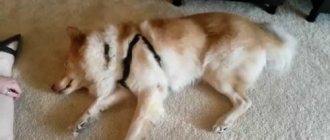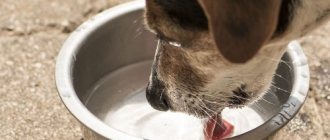Pet owners quite often observe strange behavior of their pet, because the dog chews out fur on different parts of the body. The prerequisites for this behavior can vary from an allergic reaction to the presence of a parasite on the dog’s body. In any case, the root cause of regular scratching should be determined by a veterinarian. A mandatory action on the part of the owner is not only an examination by a doctor, but also scrapings and tests. Only after this will you be able to get a truthful answer to the question of why a dog chews out its own fur.
Causes of wool chewing
When you notice for several days that your pet is still actively itching and tearing its skin, you should immediately go to the veterinarian, since such symptoms may indicate chronic diseases. Therefore, in this article we will look at why a dog chews its own fur and what the owner can do to eliminate this problem. In a word, there can be a huge number of reasons.
Make sure that your dog does not break the skin, as infection can easily get into the affected areas. The selection of medications and the effectiveness of treatment depend on a well-defined factor. Here are the most popular reasons for active scratching in an animal:
1. The root cause is getting rid of fleas, since the dog experiences discomfort and a constant feeling of itching for a long time. This causes significant damage to the skin.
2. An allergic response occurs due to powerful irritation. When a dog chews out hair near its tail, this indicates contamination or inflammation of the anal glands.
3. Atopic dermatitis - the disease is characterized by the appearance of itching, which is considered the result of the body’s reaction to various allergens. For example, such allergy triggers can be a high level of dust at home, and in addition the presence of the tiniest parasites - mites. Typically, animals suffering from this type of allergy will rapidly scratch their head, ear and muzzle. This reaction can progress in the summer, since immediately at this time the number of molds and pollen increases rapidly.
4. Allergic response to insect bites. This type of allergy occurs much less frequently than other types. However, if the pet is exposed to it, it scratches and gnaws the affected areas.
5.A severe form of wet skin disease, which refers to a bacterial infection. This type of dermatitis causes redness and can cause severe irritation. As a result, your pet will begin to scratch and chew on areas that are very itchy.
6. Due to subcutaneous mites, the dog begins to gnaw the hair on the paws and face, which are considered the main places where the insect is localized. In this case, the animal can scratch these areas until blood forms. Another feature of this skin lesion is baldness.
7.Eczema is characterized by severe itching, which forces the dog to scratch itself vigorously with both claws and teeth. With eczema, bleeding wounds may occur on the body of dogs, especially short-haired dogs. The sides, base of the tail, armpits, and the area behind the ears suffer most from this pathology.
Other factors causing itching
Owners often begin to panic, suspecting that the dog has serious illnesses, for example, chronic atopic dermatitis. However, it is necessary to understand that a factor in the appearance of discomfort in this area can be both the above-mentioned diseases, but also the following points of influence:
Poor position of the nail plates. Often, owners lose sight of the need to trim their pet's claws, which leads to their uncontrolled growth and, as a result, significant discomfort in the animal. In most cases, the dog may even move strangely when walking, as well as vigorously bite the affected areas.
Dirt between the toes of an animal. This mainly applies to the owner of the dog and his careless care or lack thereof. Over time, when many pellets of dirt have accumulated, the dog itself tries to get rid of them, while gnawing these areas of dirt.
- Damage to paw pads. Skin injury can be caused by contact with the reagent or sliding on asphalt.
- In most situations, the animal gnaws at its paws, or the dog gnaws out the fur on its thighs, which may indicate the appearance of a subcutaneous mite.
- Improper nutrition, which is characterized by an excess or lack of vitamins.
- Neurosis. Sometimes dogs suffer from this disease. Therefore, try to avoid any situations in your pet’s life so as not to disturb his psyche.
Diagnosis and treatment
To determine the cause of itching, you will need a whole range of measures:
- initial examination by a veterinarian: examination of skin lesions and identification of parasites;
- laboratory diagnostics: blood tests and waste products (feces, urine), skin scrapings, intradermal studies;
- if a systemic disease is suspected, ultrasound and x-rays are performed.
They begin to treat the animal by eliminating the root cause of the itching. If there are parasites, the pet is treated with antiparasitic agents in the form of drops and sprays. To eliminate allergies, antihistamines are prescribed, which help both neutralize the allergic reaction and relieve the accompanying itching in the dog. Injections and local therapy will help cope with skin diseases: it is recommended to smear the affected areas (eczema, lichen) and use medicinal vaccines (in particular, Vakderm).
For dermatoses, itching is relieved and the effects of scabies are eliminated with the help of disinfectants and antibacterial drugs. In severe cases, antibiotics can also help. Hyperfunction of the sebaceous glands requires clarification of the cause of the disorder and appropriate therapy. Sedative therapy and care will help you cope with the effects of stress.
How to help if a dog chews its fur?
When fleas are detected on an animal, they must be destroyed immediately. The problem is that by treating only the dog it is impossible to completely get rid of insects, since they are in the grass, in the floor and in the folds of the animal. Only if the dog has been completely treated can a flea collar be worn.
When the allergy factor is a new product introduced into the dog’s diet, such experiments should be abandoned and removed from the menu. Some manufacturers have special hypoallergenic dry food that you should switch to.
If objects or things, for example, a purchased rug, toy or feeding bowl, turned out to be a factor in the allergic manifestation, they should be removed. You also need to observe your pet for some time to be sure that the allergen has been eliminated.
For severe scabies, you will need hormonal medications prescribed by your veterinarian. In any case, the dog needs a proper diet. When inflammation of the anal glands has become a factor in chewing the fur, the cleaning should be performed by a veterinarian.
First aid
Only a veterinarian can determine exactly what is happening to a pet and prescribe the necessary treatment after a series of studies. It is only possible to make diagnoses on your own and begin treatment without consulting a specialist unless there is an obvious infection with parasites.
If there are no fleas, and the itching and attempts to pull out or bite the fur from certain places do not go away, you need to go to the clinic, having first collected the necessary information:
- When did the dog's behavior change?
- Where the animal was before symptoms appeared.
- What's new in the dog's environment?
- How often does parasite treatment take place?
- How often is the fur brushed?
In any case, regardless of the diagnosis and treatment, it is necessary to completely disinfect the home and all household items of the pet in order to exclude the possibility of relapse of the disease.
Brief conclusion
Please note that when a dog itches and chews itself, you should not panic, you need to take specific measures. When you cannot independently determine the cause of this behavior, you should consult a doctor. Do not self-medicate under any circumstances, as this can make your pet feel worse. When the dog does not stop itching for a long period, there is no need to put off visiting the doctor, because sometimes the dog needs emergency help.
Currently reading:
- Thyroid dysfunction in dogs (hypothyroidism)
- Recommendations for obedience of a dog if it growls
- Recovery and nutrition of a dog after sterilization
- The first symptoms of a stroke and its treatment in a dog
Stress causes itching
After examining the dog, it turned out that she did not have fleas, but the pet was still itching. In this case, there is a possibility that the itching is caused by nerves. A dog is susceptible to stress in much the same way as a person, and the symptoms of this condition are identical. Especially if the animal is constantly being trained or is in service. When a pet wants to have its belly or other parts of the body scratched before going to bed, and shows signs of anxiety, this is a signal of nervous overexcitation. There are no difficulties in treating a dog for stress; it is enough to provide the animal with a good diet, complete rest, protect it from strangers and exclude group walks for a while. Your beloved pet will definitely recover and stop scratching itself unnecessarily, but this will take time.
Introduction
Parasitism is life at the expense of the host organism, which can be any animal or person. This is the most common way of existence of living beings in nature. Therefore, it is not surprising that parasites in dogs are a common cause of itching and skin diseases.
Some of them live only on animals and are transmitted through direct contact with sick dogs or cats, others live in the environment, and healthy dogs can become infected simply by walking in the forest or on the lawn near the house. In addition, a dog can become infected with parasites without even leaving the apartment through contact with outdoor shoes or through a mosquito bite.
Excessive grooming
With frequent use of animal hair care products, the chemical components contained in their composition can injure the skin, dry out and cause itching. Thickening and flaking cause hair loss. For your dog's health, it is enough to clean it with chemicals once every couple of months.
Parasites
In addition to allergic reactions, substances contained in insect saliva cause irritation and inflammation. The site of the parasite bite is itchy and causes anxiety in the pet. If a dog is heavily infested with fleas, lice or lice, it can tear out hair and damage the skin by biting them.
Scabies and hair loss can be caused by intradermal parasites – scabies mites. It is not easy to detect a parasite in a pet’s thick fur, and it is even more difficult to remove it. Female mites cause damage to the animal's skin by laying eggs and feeding, which causes itching and weakens and damages hair follicles.











